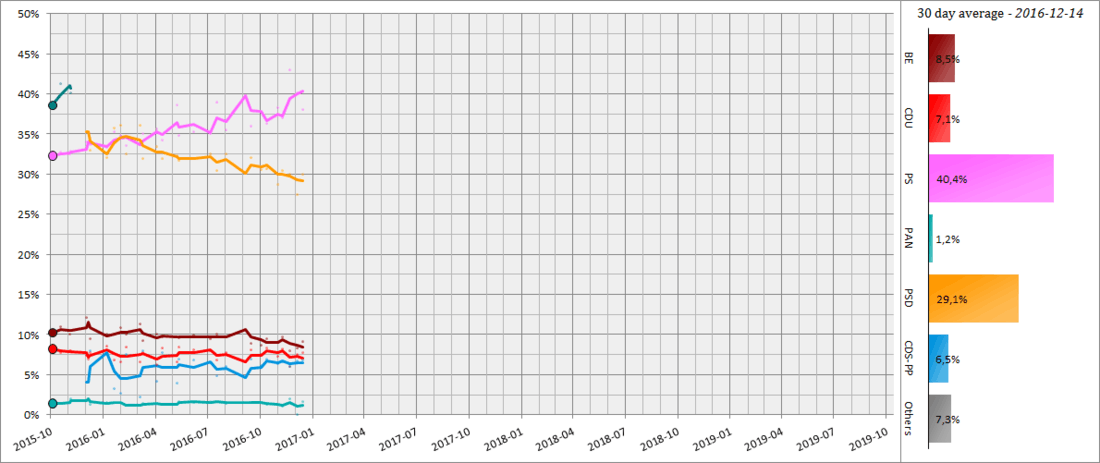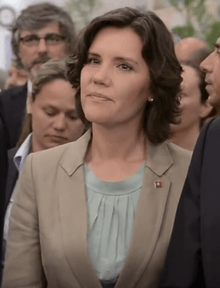Next Portuguese legislative election
| | |||||||||||||||||||||||||||||||||||||||||||||||||||||||||||||||||||||||
| |||||||||||||||||||||||||||||||||||||||||||||||||||||||||||||||||||||||
| |||||||||||||||||||||||||||||||||||||||||||||||||||||||||||||||||||||||
| |||||||||||||||||||||||||||||||||||||||||||||||||||||||||||||||||||||||
The Next Portuguese legislative election will be held no later than October 2019. At stake will be all 230 seats to the Assembly of the Republic.
Background
Politics of Portugal
The President of Portugal has the power to dissolve the Assembly of the Republic by his own will. Unlike other countries the President can refuse to dissolve the parliament at the request of the Prime Minister or the Assembly of the Republic and all the parties represented in Parliament. If the Prime Minister resigns, the President must nominate a new Prime Minister after listening to all the parties represented in Parliament and then the government programme must be subject to discussion by the Assembly of the Republic, whose members of parliament may present a motion to reject the upcoming government.
Date
According to the Portuguese Constitution, an election must be called between 14 September and 14 October of the year that the legislature ends. The election is called by the President of Portugal but is not called at the request of the Prime Minister; however, the President must listen to all of the parties represented in Parliament and the election day must be announced at least 60 days before the election.[1] If an election is called during an ongoing legislature (dissolution of parliament) it must be held at least in 55 days. Election day is the same in all multi-seats constituencies, and should fall on a Sunday or national holiday. The next legislative election must, therefore, take place no later than 13 October 2019.[2]
Electoral system
The Parliament of the Portuguese Republic consists of a single chamber, the Assembly of the Republic, composed of 230 members directly elected by universal adult suffrage for a maximum term of four years. Assembly members represent the entire country, rather than the constituencies in which they were elected. Governments do not require absolute majority support of the Assembly to hold office, as even if the number of opposers of government is larger than that of the supporters, the number of opposers still needs to be equal or greater than 116 (absolute majority) for both the Government's Programme to be rejected or for a motion of no confidence to be approved.[3]
Each one of Portugal's eighteen administrative districts, as well as each one of the country's two autonomous regions - the Azores and Madeira - is an electoral constituency. Portuguese voters residing outside the national territory are grouped into two electoral constituencies - Europe and the rest of the world - each one of which elects two Assembly members. The remaining 226 seats are allocated among the national territory constituencies in proportion to their number of registered electors.
Political parties and party coalitions may present lists of candidates. The lists are closed, so electors may not choose individual candidates in or alter the order of such lists. Electors cast a ballot for a single list. The seats in each constituency are apportioned according to the largest average method of proportional representation (PR), conceived by the Belgian mathematician Victor d'Hondt in 1899. Although there is no statutory threshold for participation in the allocation of Assembly seats, the application of the d'Hondt method introduces a de facto threshold at the constituency level.[4]
Parties
The parties represented in Parliament are:
| Political party | Leader | Political spectrum | Political groups of the European Parliament |
|---|---|---|---|
| Social Democratic Party (PPD/PSD) | Pedro Passos Coelho | Centre-right | European People's Party Group (EPP) |
| Socialist Party (PS) | António Costa | Centre-left | Progressive Alliance of Socialists and Democrats (S&D) |
| Left Bloc (BE) | Catarina Martins | Left-wing | European United Left–Nordic Green Left (GUE/NGL) |
| CDS – People's Party (CDS-PP) | Assunção Cristas | Centre-right to Right-wing | European People's Party Group (EPP) |
| Unitary Democratic Coalition (CDU) • Portuguese Communist Party (PCP) • Ecologist Party "The Greens" (PEV) |
Jerónimo de Sousa | Left-wing | European United Left–Nordic Green Left (GUE/NGL) |
| People-Animals-Nature (PAN) | André Silva | Centre-left | No members of European Parliament |
Opinion polling

See also
Notes
References
- ↑ http://app.parlamento.pt/site_antigo/ingles/cons_leg/Constitution_VII_revisao_definitive.pdf
- ↑ Electoral law to the Assembly of the Republic
- ↑ "Constitution of the Portuguese Republic" (PDF).
- ↑ "Election Resources on the Internet: Portugal - The Electoral System". Electionresources.org. Retrieved 2014-08-04.
External links
- Popstar Poll Tracker
- Marktest Opinion Poll Tracker
- Official results site, Portuguese Justice Ministry
- Portuguese Electoral Commission
- ERC - Official publication of polls
.jpg)
.jpg)
.jpg)

.jpg)
